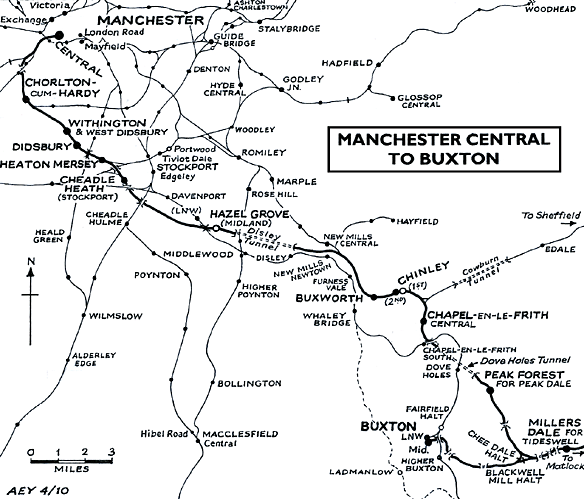Notes: Hazel Grove’s Midland Station was situated on the Midland Railway’s (MR) New Mills to Heaton Mersey line which formed part of its main line between Manchester Central and Ambergate.
 |
The New Mills to Heaton Mersey line was built purely to make MR services between Manchester Central and London St Pancras faster. The MR had first reached Manchester in 1867. However they did not have their own station in the city. The MR had to use the Manchester Sheffield and Lincolnshire Railway’s (MSLR) line from New Mills to Hyde and the MSLR |
line from Hyde to the London North Western Railway (LNWR) terminus at Manchester London Road. Although the MR and MSLR had an amicable relationship the same could not be said with regards to the MR and the LNWR. Through partnership and take over the MR was able to establish a route into Manchester Central Station from the 1st January 1880. Manchester Central was a Cheshire Lines Committee (CLC) station and the MR was held a third of the shares in the CLC. The other two shares were held by the MSLR and the Great Northern Railway (GNR) who each also held a third shares of the CLC.
The MR route to Manchester Central ran from New Mills to Manchester Central via the CLC Woodley to Glazebrook line which ran through Stockport Tiviot Dale. To the west of Stockport trains turned north onto the MRs own Manchester South District Line which passed through Heaton Mersey and Didsbury. Although Stockport provided many passengers the route was not direct and with lots of junctions it was quite slow. The solution was to build a direct line between New Mills and Heaton Mersey for a cost of £2 Million. The new line would allow fast express services to substantially improve journey times for trains running between London St Pancras and Manchester and between the capital and Liverpool.
The new line was authorised in 1898 and work began immediately. Despite the need for some very heavy engineering, including the construction of a two mile long tunnel at Disley, the New Mills South to Heaton Mersey Junction line was opened in stages, Heaton Mersey Junction to Cheadle Heath for passenger traffic (including Cheadle Heath station) on 1st October 1901 and goods traffic on 4th May 1902. New Mills South Junction to Cheadle Heath including Hazel Grove station opened for passenger traffic on 1st July 1902.
Hazel Grove MR Station was provided with one island platform which provided two platform faces. The platform was reached by means of a subway and the station was provided with a single storey building that provided the usual facilities. The station had a limited service, which changed over the years. It was not very convenient for passengers being some distance from most houses and businesses. The town had a much more convenient LNWR station on that company's Stockport to Buxton line.
During the Great War the station was closed as an economy measure on the 1st January 1917. It never re-opened. After closure the buildings were demolished but the platform remained in situ for many years.
While the line remained open for passenger traffic until May 1969, the London and Nottingham to Manchester Central expresses were diverted into Piccadilly (via Marple) from 1st January 1968. After that date and up until 1986 the New Mills to Heaton Mersey line was only used by freight trains. In May 1986 a link, the Hazel Grove Chord, in the form of a single track spur was opened from a point just to the west of Hazel Grove’s Midland station to a point just to the south of Hazel Grove’s former LNWR Station. The Hazel Grove Chord allowed express trains from Manchester Piccadilly to Sheffield to run via Stockport. New life was brought to the southern end of the New Mills to Heaton Mersey line. Going westwards from Hazel Grove however the line was singled and now forms a link to Northenden Junction which is only used by freight trains.
Sources: The Midland Route From Manchester, Part 2 (Cheadle Heath To Chinley) by E.M. Johnson. Published 1992 by Foxline Publishing ISBN 13 978-1870119207. Lost Railways of Merseyside and Greater Manchester by Gordon Suggitt. Published 2004 by Countryside Books ISBN 13: 978-1853068690 Through Limestone Hills by Bill Hudson. Published by OPC 1989 ISBN 978-0860932178 Railways across the Pennines by Stanley Jenkins and Howard Quayle. Published 1990 by Littlehampton Book Services ISBN-13: 978-0711018402
Ticket from Glynn Waite, route map drawn by Alan Young, additional source Glynn Waite.
To see other stations between Manchester Central & Matlock click on the station name: Manchester Central, Chorlton-cum-Hardy, Withington & West Didsbury, Didsbury, Heaton Mersey, Cheadle Heath, Buxworth, Chinley (2nd site) STILLOPEN, Chinley (1st site), Chapel-en-le-Frith Central, Peak Forest, Cheedale Halt, Buxton (Midland), Blackwell Mill Halt, Millers Dale, Monsal Dale, Great Longstone, Hassop, Bakewell, Rowsley (Second site), Rowsley (First site), Rowsley South PEAK RAIL, Darley Dale, Matlock Riverside PEAK RAIL & Matlock STILL OPEN. See also Stockport Tiviot Dale & Stockport Portwood |

grove_old1.jpg)


grove1.jpg)
grove4.jpg)
grove7.jpg)



grove_thumb1.jpg)
grove_thumb2.jpg)
grove_thumb5.jpg)
grove_thumb6.jpg)
grove_thumb8.jpg)

 Home Page
Home Page